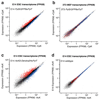Genetic code expansion in stable cell lines enables encoded chromatin modification
- PMID: 26727110
- PMCID: PMC4888942
- DOI: 10.1038/nmeth.3701
Genetic code expansion in stable cell lines enables encoded chromatin modification
Abstract
Genetically encoded unnatural amino acids provide powerful strategies for modulating the molecular functions of proteins in mammalian cells. However, this approach has not been coupled to genome-wide measurements, because efficient incorporation of unnatural amino acids is limited to transient expression settings that lead to very heterogeneous expression. We demonstrate that stable integration of the Methanosarcina mazei pyrrolysyl-tRNA synthetase (PylRS)/tRNA(Pyl)CUA pair (and its derivatives) into the mammalian genome enables efficient, homogeneous incorporation of unnatural amino acids into target proteins in diverse mammalian cells, and we reveal the distinct transcriptional responses of embryonic stem cells and mouse embryonic fibroblasts to amber codon suppression. Genetically encoding N-ɛ-acetyl-lysine in place of six lysine residues in histone H3 enables deposition of pre-acetylated histones into cellular chromatin, via a pathway that is orthogonal to enzymatic modification. After synthetically encoding lysine-acetylation at natural modification sites, we determined the consequences of acetylation at specific amino acids in histones for gene expression.
Conflict of interest statement
The authors declare no competing financial interest.
Figures





References
-
- Chin JW. Expanding and Reprogramming the Genetic Code of Cells and Animals. Annu Rev Biochem. 2014;83:379–408. - PubMed
-
- Davis L, Chin JW. Designer proteins: applications of genetic code expansion in cell biology. Nature Rev Mol Cell Biol. 2012;13:168–182. - PubMed
-
- Baker AS, Deiters A. Optical control of protein function through unnatural amino acid mutagenesis and other optogenetic approaches. ACS chemical biology. 2014;9:1398–1407. - PubMed
-
- Lang K, Chin JW. Cellular incorporation of unnatural amino acids and bioorthogonal labeling of proteins. Chem Rev. 2014;114:4764. - PubMed
Publication types
MeSH terms
Substances
Grants and funding
LinkOut - more resources
Full Text Sources
Other Literature Sources
Molecular Biology Databases

